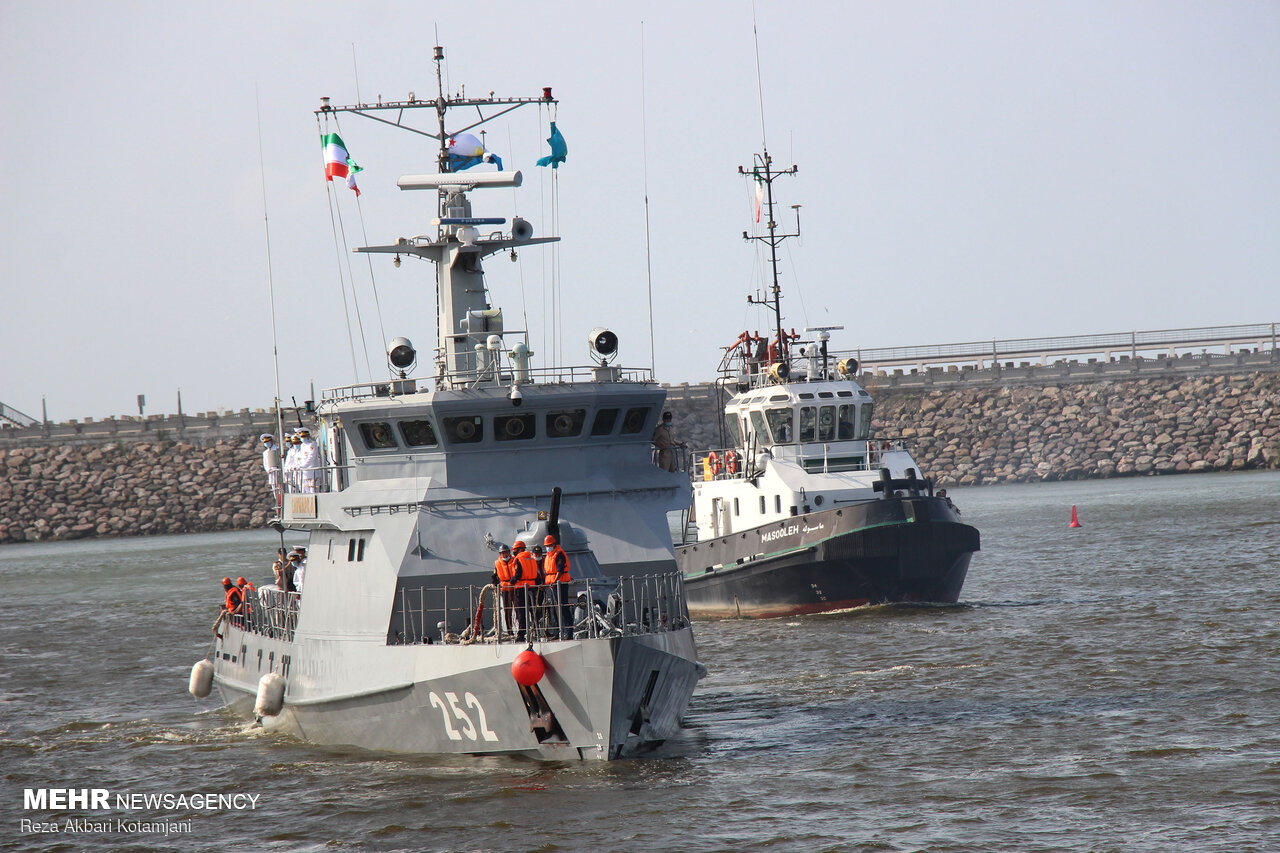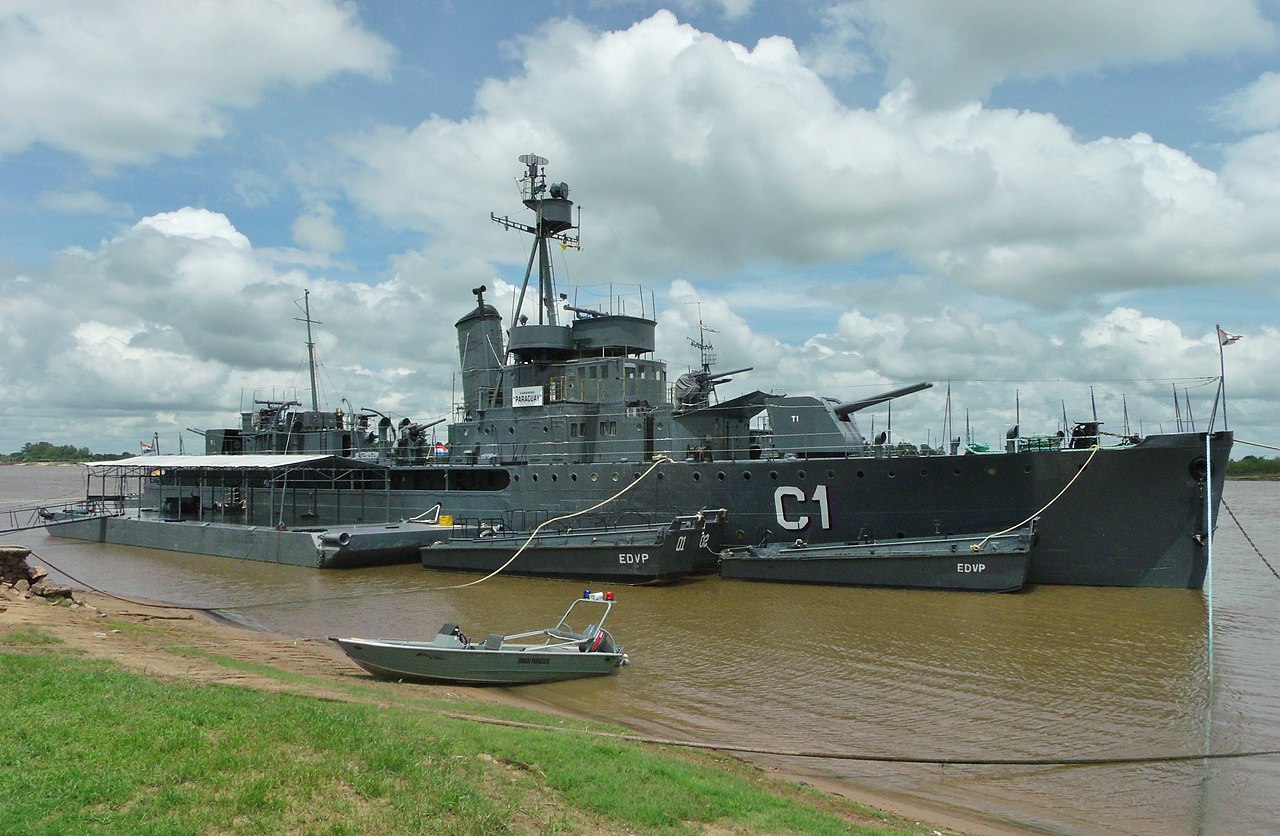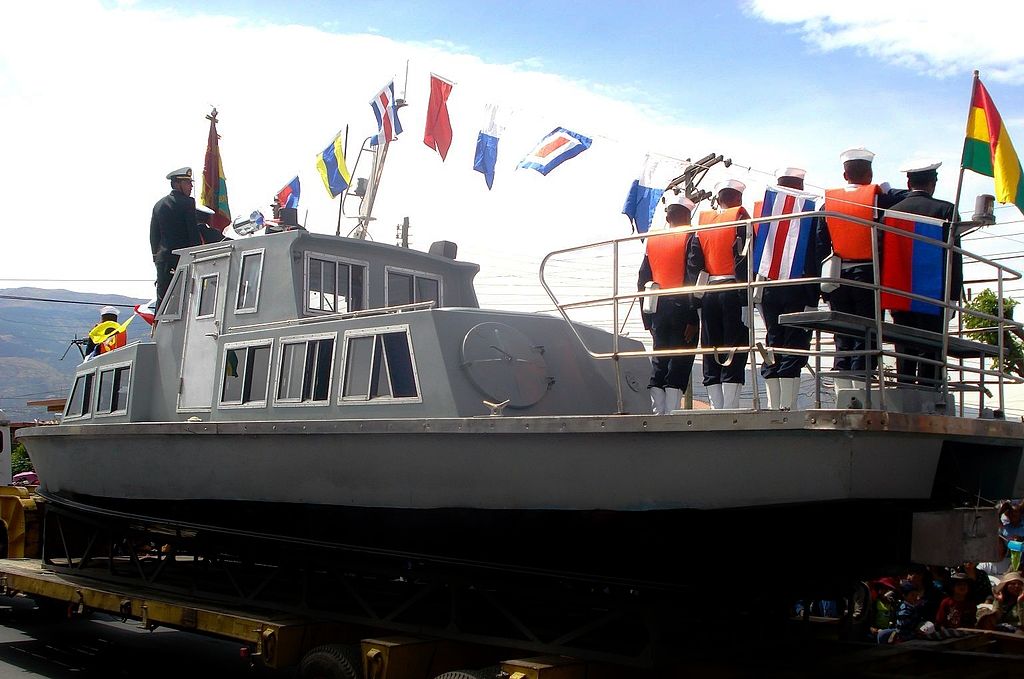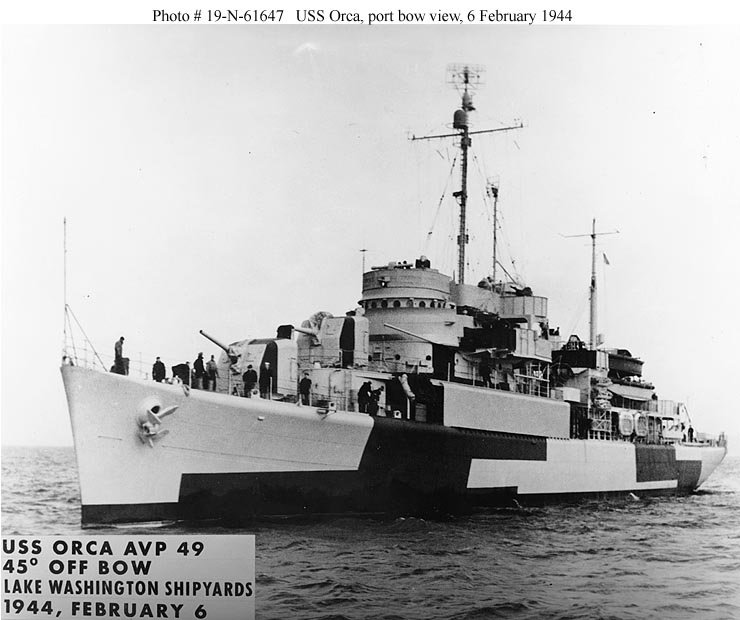Weirdly, the possession of navies is not the exclusive providence of countries with coastlines. At least five landlocked states maintain navies, usually with thousands of personnel. The first-level reasons for this shouldn't surprise long-time readers. All of them exist because of our old friend riverine warfare, operating on lakes and rivers that border these countries. But there are lots of landlocked countries with important rivers and lakes, and most of them sensibly make them part of the Army instead of giving them institutional independence as a separate branch.1

Ships of the Kazakh navy
So what makes these 5 countries - Azerbaijan, Bolivia, Kazakhstan, Paraguay and Turkmenistan - different? Two factors spring to mind: first, most of them have very significant riverine commitments for landlocked states. Azerbaijan, Kazakhstan and Turkmenistan all border the Caspian Sea, which is large enough to operate substantial ships on, while Paraguay has a very significant and eponymous river. Second, in most cases they have an institutional connection to a proper, oceangoing navy. The connection for the Caspian powers is obvious. The Caspian flotilla was managed by the Soviet Navy, and when the Soviet Union dissolved, the new countries received some of the naval units. If you need to operate reasonably large ships (the biggest warships on the Caspian are over 1,000 tons) and you already have a separate Navy with institutional power and expertise, folding it into the Army is probably more trouble than it is worth.
That just leaves the South American states. Paraguay has an extensive river system, with both the Paraguay and Parana rivers navigable by oceangoing ships to ports on the country. As a result, the Paraguayan Navy is by far the oldest of the landlocked navies, dating back to 1811, and it has fought in wars against a number of Paraguay's neighbors, including the largest-ever naval battle between South American navies. Of all the landlocked navies, this is by far the least surprising, given both institutional history and the need to operate ships of hundreds of tons in a manner closer to that of a traditional seagoing navy.

Gunboat Paraguay
But there is one nation not mentioned here, Bolivia, which has by far the weirdest of the landlocked navies. Before 1879, Bolivia had a coastline, although no navy. That year, war broke out with Chile, and despite Peruvian assistance, Bolivia's coastline was soon conquered in the resulting War of the Pacific. Peru did have a navy, and there were several ironclad clashes off the coast, while Bolivia attempted to join the naval fun by offering letters of marque. Privateering had been outlawed 20 years earlier, although Bolivia hadn't signed, and thanks to the diplomatic efforts of Britain, France and the US,2 Bolivia got no takers.
For the next 80 years, Bolivia had no navy, although the loss of access to the Pacific left deep scars on the national psyche. But in 1963, a new Bolivian Navy was established, to operate on Bolivia's river systems and on Lake Titicaca, the highest navigable lake in the world. Personnel were largely transferred from the Army, and it is likely that this was splitting out an existing force into a new service. As best I can tell without getting too deep into Bolivian history, there was significant tension between the two nations over access to the sea at this point, and the creation of an independent navy was seen as a way to fortify Bolivia's claims and channel popular support, probably in an attempt to quell internal tensions that led to a military revolution the next year. The Bolivian Navy has remained independent ever since, growing to be the largest of the landlocked navies, although reports indicate that a significant fraction of its personnel work on such maritime tasks as raising guinea pigs and automotive repair, in addition to patrolling Bolivia's rivers against smugglers and performing various humanitarian and development duties along Bolivia's waterways.

The Bolivian Navy conducts a major exercise
Bolivia also continues to try and regain access to the Pacific, although the legal position that they have no particular right to such access was confirmed in a 2018 court case, and Chile has no particular incentive to grant any concessions in the matter going forward. Peru and Argentina have both hosted various training detachments, and at one point, they could even claim a seagoing training ship, the Liberator Bolivar, based in Argentina, although it appears to be out of service today. As it stands, the Bolivian navy is likely to remain a landlocked oddity, a weird national coping mechanism for a loss the country has yet to come to terms with.
The Wiki article on landlocked navies mentions3 two I haven't discussed here, Uganda and Laos. I am fairly certain that Uganda is a simple mistake. There's no reference outside the article to any Ugandan navy, and it is more likely that this is a straightforward maritime wing of the Army that someone misunderstood. The lack of any details on size, and the rather informal structure of many African militaries also suggest that this is not a true navy in any sense.
The case of Laos is a bit more complicated. The country has an extensive river system in the Mekong and its tributaries, and it appears that the naval wing of the Laotian forces was set up by the French Navy, which was responsible for riverine operations in the Far East. This appears to have led to more independence than a relatively small force would expect in the 60s and 70s, and which might have been maintained after the communists took over in the mid-70s. Unfortunately, there is little information on the state of things today, and while most sources continue to claim independent status for the Laotian People's Navy, although Global Security suggests that it may have become the Army Marine Section4 instead. In any case, it looks to be a clear outlier in size and operational terms from the other landlocked navies.

Orca before she became Ethiopia
The last navy we turn to is that of Ethiopia, which like that of Bolivia was cut off from the sea by the loss of the relevant coastline, in this case when Eritrea became independent in 1991. But unlike Bolivia, Ethiopia previously had a navy, and under Emperor Haile Selassie, it had been a prestige service, although it lacked any vessel larger than the former seaplane tender Orca, which was renamed Ethiopia and used as a training ship. After Haile Selassie was overthrown, the communists who took power were less interested in the Navy, and it began to wither despite Soviet support and a few new ships. The Eritreans were not particularly happy with the communists, and the Navy found its bases under threat from the resulting rebellion. In 1990, the Eritreans overran the Navy's main base, forcing the remaining ships to fleet to an alternate base and leaving them short on spares. The rebels overran their last haven a year later, forcing the ships that were still seaworthy to head for foreign ports, primarily Aden. Eritrea became independent later that year, although the Ethiopian Navy limped on for a few more years, patrolling the Red Sea from Yemen until 1993, when the Yemenis got fed up and kicked the units that were still seaworthy out. Discussions to lease port space from Eritrea or to organize a joint Navy fell through, and the only partner who could be found was Djibouti, always a haven for any foreign military willing to pay.5 Unfortunately, the Ethiopians couldn't, and in 1996, the remaining ships were seized and put up for auction. Eritrea bought a few missile boats, and the rest of the vessels were scrapped. Later that year, the Ethiopian Navy was officially disbanded. In 2018, plans were announced for Ethiopia to reform its Navy, basing the ships in Djibouti once again, but nothing seems to have come of them.
Ultimately, the navies of landlocked states are fascinating not only for their weirdness, but for the lessons we can learn about organizational structure and the importance of history in it. From Bolivia, which essentially has a navy out of spite, to the quite impressive force of Paraguay and the silliness of Ethiopia, they are a useful lesson in the diversity of structures within the maritime world.
1 Yes, I am aware that in theory some countries - most notably Canada - might not have independent navies by these standards. I don't think it's possible to solve that problem in a general and satisfactory way, but at the same time, there are definitely landlocked maritime forces with more and less independence, and I'm looking at the more independent ones here. ⇑
2 Note that this was despite the US also not signing the ban on privateering, and conclusively establishes that we have also accepted that. STOP SUGGESTING WE ISSUE LETTERS OF MARQUE. ⇑
3 Technically, this is no longer true, as a reader kindly edited out the mention of Uganda after this post went up. ⇑
4 Note that contra what the author of that piece suggests, I'm pretty sure "Marine" here means "nautical" instead of "amphibious". ⇑
5 I am not trying to be mean here. Today, Djibouti hosts forces from France, the United States, Japan and China, all of whom are interested in protecting the vital shipping lanes off Somalia. The rent on the bases makes up around 5% of the country's GDP. ⇑

Comments
should probably be 'despite Peruvian assistance' for clarity
Not sure what this is to mean:
the communists who took power reoriented towards the Soviet Union and bought a were less interested in the Navy, and it began to wither despite Soviet support.
Probably the Paraná River and not the Panara.
Or the Panaro, which is in Italy, which has an ocean going Navy.
Should we mention the Swiss Navy, which is probably only of interest for one of the Royal Navy traditions, as listed by Lord Churchill?
https://www.amazon.com/Swiss-Premium-Silicone-Lubricant-Science/dp/B07TDSTK25
Such small ships means Army ranks would be more likely to give them a post Captain.
So the US Navy doesn't use cars, instead insisting on everyone using a boat even where there isn't any water?
First, apologies for the late replies. A bird strike delayed travel plans, though sadly it was on the plane we were supposed to get on, so I didn't get a good story out of it.
@ike
Good point.
@The Fatherly One
Editing error.
@Emilio
Oops.
@Anon
In most cases, a Captain might be the guy in charge of the entire riverine force.
Definitely. They're allowed to use hovercraft ashore at a pinch. (More seriously, the USN doesn't run an auto repair training program out of proportion to the number of cars it needs fixed. The Bolivian Navy does.)
Also, is it worth pointing out that the Caspian Navies can get to the high seas if Russia, Turkey, AND Egypt/Britain/Spain say yes?
Thinking about whether Paraguay really is landlocked if it has an oceanic port makes my head hurt (Kind of like Pennsylania?).
@Ike: Wikipedia gives the Volga-Don canal a draft limit of 3.6 m; Russia's two Gepard-class frigates on the Caspian draw a nominal 5.7 m. It might be possible to get them through in a maximally-offloaded condition, but tricky at best. Everything else on the Caspian, yes, can get to the Black Sea if Russia is OK with that.
Adjacently, the interwar Kingdom of Hungary is an obligatory joke. It lost its coastline at the end of WW1, but ended up being ruled by Admiral Miklós Horthy from 1920 to 1944. (Also, he was a regent throughout; the ostensible Habsburg king, Charles IV, who had already sat on the Hungarian throne during WW1, attempted to reclaim it in 1921, but the Entente vetoed the idea.)
Also to the Baltic or the White Sea, and the Gepards apparently do fit at least one exit, as the Caspian ones and the Vietnam ones were built in the same place.
No.
Alternatively: how about Letters of Reprisal?
@Basil Marte
King Karl is under consideration for sainthood.
I thought Caspian Sea Flotilla ships were transported over land (somehow).
I suspect many of the smaller patrol craft on the Caspian are mass-produced elsewhere and transported by road or rail, possibly in sections. But the Russians at least have a Caspian shipyard that can build a small frigate, and I think that's where most of the larger ships of the post-Soviet navies came from. Looks like Iran also has a Caspian shipyard in that class.
Removed Uganda from Wikipedia.